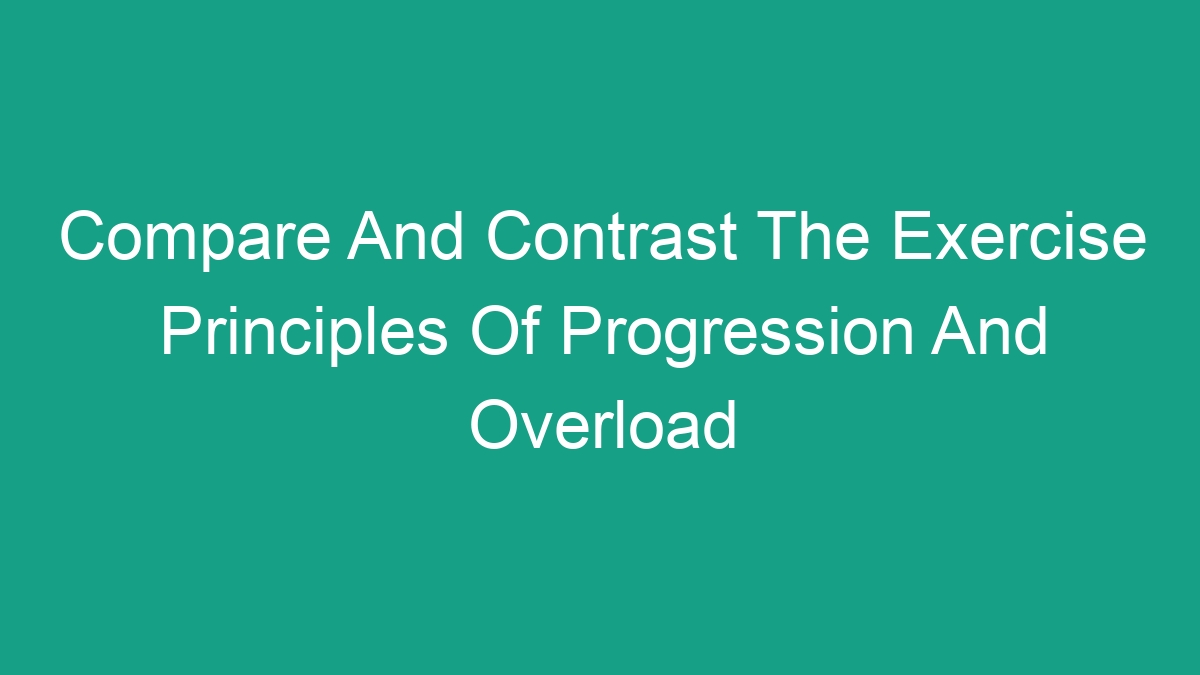
Introduction
When it comes to designing effective workout routines, understanding the exercise principles of progression and overload is crucial. Both principles play a significant role in determining the success of an exercise program and are essential for achieving fitness goals. In this article, we will compare and contrast the exercise principles of progression and overload, exploring their similarities, differences, and how they can be applied to create effective workout plans.
Understanding the Principles
Progression and overload are two essential principles in the field of exercise science. They are vital for improving physical fitness, strength, and endurance. Understanding these principles is crucial for anyone looking to make progress in their fitness journey.
Principle of Progression
The principle of progression states that in order to improve fitness levels, exercise workload must be increased gradually over time. This means that the intensity, duration, and frequency of exercise must be incremented in a systematic manner to achieve continued improvement. The body’s adaptive response to stress is what drives the principle of progression.
Principle of Overload
The principle of overload, on the other hand, focuses on the need to impose a greater than normal stress or load on the body to elicit an adaptive response. This principle states that in order for a training effect to occur, the individual must work harder than they are accustomed to. This can be achieved by increasing the intensity, frequency, or duration of the exercise.
Comparison
While progression and overload are distinct principles, they are closely related and often work in tandem to produce desirable fitness outcomes. Both principles are designed to challenge the body and promote adaptation, but they do so in slightly different ways.
Similarities
– Both progression and overload require the body to be subjected to a greater fitness challenge over time.
– Both principles rely on the body’s ability to adapt to increased demands, leading to improved physical performance and fitness.
Differences
– The principle of progression focuses on the incremental increase of exercise workload over time, ensuring that the body is given the opportunity to adapt gradually. This can be achieved by manipulating factors such as intensity, duration, and frequency of exercise.
– The principle of overload, on the other hand, emphasizes the need to push the body beyond its comfort zone in order to stimulate adaptation. This can be achieved by increasing the overall workload to a point where the body is forced to adapt to the new demands.
Application
Both progression and overload are crucial components of an effective exercise program. By understanding how to apply these principles, individuals can design workout routines that effectively challenge the body and lead to fitness improvements.
Progression in Action
– When applying the principle of progression, individuals can gradually increase the intensity of their workouts. For example, someone looking to improve their strength may start with lighter weights and then gradually increase the load over time.
– Progression can also be applied by slowly increasing the duration or frequency of exercise sessions. For example, someone aiming to improve their cardiovascular fitness may start with shorter runs and then gradually increase the distance or frequency of their runs.
Overload in Action
– Implementing the principle of overload may involve pushing the body to perform at a higher intensity than it is used to. For example, someone looking to improve their cardiovascular fitness might incorporate high-intensity interval training (HIIT) into their workouts.
– Overload can also be achieved by increasing the workload in a single exercise session. For example, someone looking to build muscle strength might increase the weight they are lifting during a set of squats.
Considerations
While both progression and overload are crucial for improving fitness levels, it is important to apply these principles in a safe and effective manner. Failure to do so can lead to overtraining, injury, or burnout.
Progression Considerations
– It is important to progress gradually and listen to the body’s signals. Pushing too hard, too fast can lead to overuse injuries and burnout.
– Individuals should monitor their progress and adjust their workout routines accordingly. This may involve increasing the intensity of the workouts or taking deload weeks to allow the body to recover.
Overload Considerations
– Overloading the body without proper recovery can lead to overtraining and injury. It is important to give the body adequate time to rest and recover between challenging workouts.
– Variety is key when implementing overload. This can help prevent plateaus and reduce the risk of overuse injuries.
Conclusion
In conclusion, both the exercise principles of progression and overload are crucial for improving physical fitness, strength, and endurance. While these principles have their differences, they ultimately work towards the same goal of challenging the body to adapt and improve. By understanding how to effectively apply these principles, individuals can design workout routines that promote continuous improvement and success in their fitness journey. It is important to apply these principles in a safe and sustainable manner, taking into consideration the body’s need for rest and recovery. When utilized properly, progression and overload can lead to significant improvements in overall fitness and performance.


